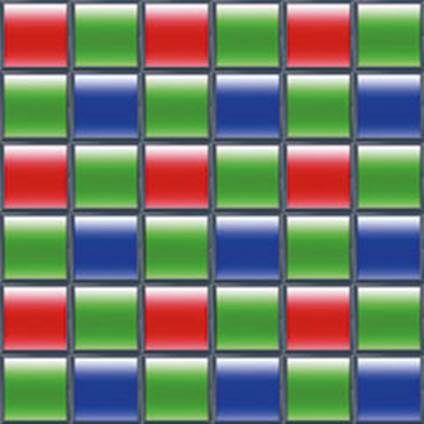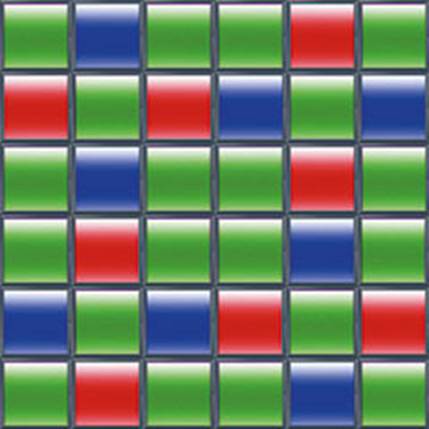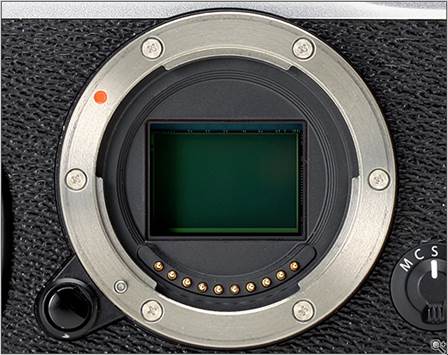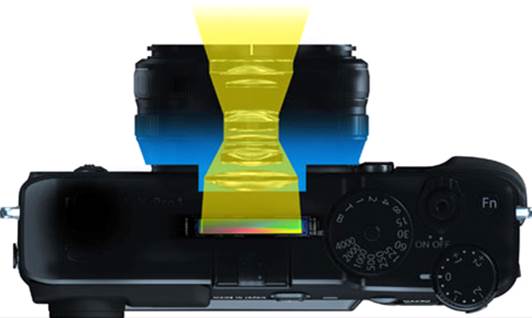Core technology
Fujifilm
X-Trans CMOS sensor
The XE-1 uses the same X-Trans sensor,
which means using a non-standard filter template in front of the sensor. As a
result, according to Fujifilm, it is the minimum susceptibility to color moiré,
which allows the company to dispense with the anti-aliasing filter used by the
other cameras. In principle, this means that the X-E1 can handle more detail
than the Bayer array cameras with the same pixel count.
The color filter array
Almost all digital cameras use what it
called a Bayer color filter array, named after the Kodak engineer who invented
that model. Over the years it has proved to be an excellent way to capture both
of the color and detail in the scene. Basically, it includes a simple repeating
four-pixel pattern, two of which are sensitive to green light, one to red and
one to blue, in a square RGGB layout.
However, a problem with the Bayer array is
its sensitivity to false color artifacts when faced with images that contain
subtly-repeating patterns (such as textile fibers), essentially caused by the
interference between these patterns and the usual lines of single sensitive
factor. This causes the negative bands of color, and in most digital cameras that
are suppressed by the addition of an optical low pass filter (or anti-aliasing)
in front of the sensor that blurs away the subtlest detail images. This reduces
any moiré patterns, but with a certain loss of resolution.
Movies never displayed a similar effect due
to its random grain structure, and Fujifilm’s engineers explained that the
adjustment of the sensor’s color filter array to make it seem to be more
irregular would have an equivalent effect. As a result it has the X-Trans
CMOS's 6x6 color filter array, with red, green and blue single sensitive
factors on each row and column (Fujifilm’s own ranking):

The
common 2x2 Bayer pattern used in most digital cameras

The
Fujifilm of X-Trans CMOS sensor’s 6x6 color filter array pattern
Even so, using an unconventional CFA is
indispensable to its complexity; the most obviously, it requires a Demosaicing
algorithm that is completely different for RAW conversion. Compared with simply
refining the Bayer conversion processes that they have polished over a decade
or more, the developers had to start again from the beginning. There are better
abilities to make the switch of artifacts in areas of the image that are able
to require special handling. In spite of the plans to work with Fujifilm’s
third party Raw processor manufacturer, a great variety of common converters do
not support the X-Pro1, which is a problem that prolongs to the X-E1.
In the review of the X-Pro1, we discovered
the Adobe Camera Raw’s converter lagged behind the standards that we normally
expected of it, and the Fujifilm’s converting software offered seemed to have
more problems than X-Trans filter array’s Demosaicing algorithm. This looked
like it was able to limit the XE-1’s options for shooting RAW. However, shortly
before the release of this review, Adobe Launched A New Version Of ACR Targeting
At Most Of Our Concerns, With A Better, More Natural Showing Of Sophisticated
Detail (See Our RAW Page For More, As Well As For Detailed Articles, Adobe's
Fujifilm X-Trans Sensor Processing Reviewed).
Fully-electronic
X mount
As a second camera offers the Fujifilm’s
X-mount, the X-E1 offers little surprise to anyone who has been observing the
recent developments of the mirrorless camera systems, being a fully-electronic
bayonet mount with ten contact pins to impart between the camera and lens.
X-mount lenses have aperture and focus rings that look like the traditional
ones, but they do not have direct mechanical connection, and do not work when
the lens is removed from the camera.

Fully-electronic
bayonet mount with ten contact pins
Announcing the famous X-mount, however, is
an extremely short-range edge of 17.7mm (from the mount surface to the sensor)
– even shorter than Sony’s E-mount for its NEX system. The lenses themselves
have unusual functions with the short back-focus distance from the edge element
to the sensor and use larger edge elements to maximize the illumination of the
angles of the frame. The graph below (supplied by Fujifilm) demonstrates this
principle, here showing a perfectly simulated vision of the 18mm placed on the
X-Pro 1:

Demonstrating
a perfectly simulated vision of the 18mm